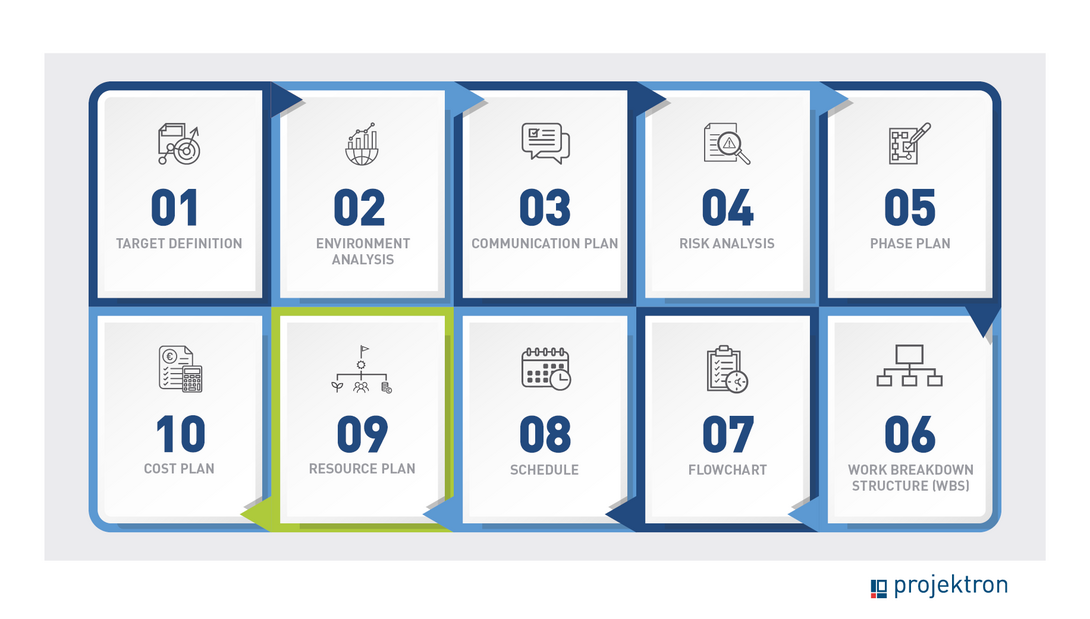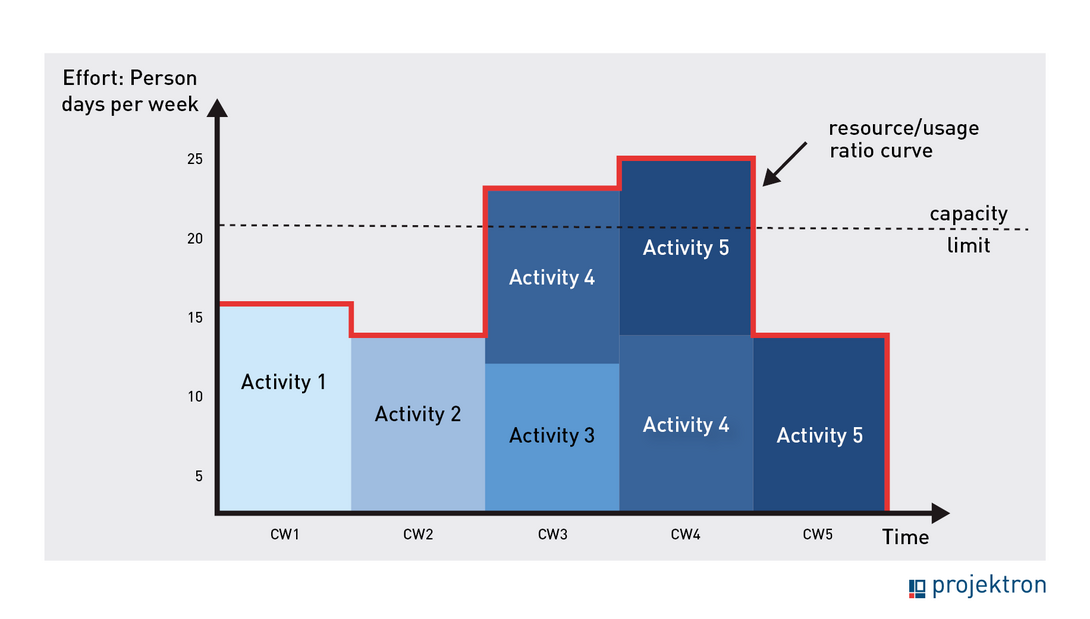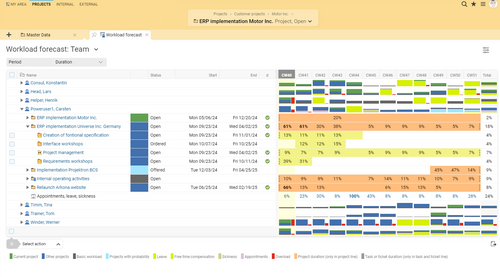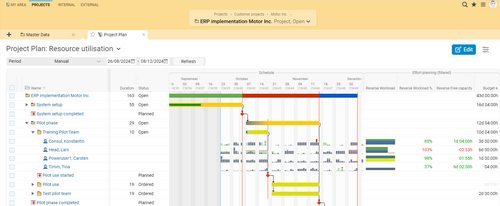06/21/2023 - Articles
Resource planning in project management: why a resource plan is indispensable
Resource planning is a strategically important step in project management. Its goal is to ensure that sufficient resources are available for a project or project portfolio at the right time and that they are used efficiently in line with project and company goals. What is a resource plan? What information does it contain? What are the benefits of resource planning in project management? How do you create a resource plan? Why is it advisable to use software for resource planning? In this article, we will take a closer look at all these aspects of resource planning and show you how to use it effectively for yourself.
Content:
- What does resource planning mean?
- Resources in project management
- Tasks of resource planning
- Difference between resource planning and resource management
- Content of the resource plan
- When to create resource plan?
- Why resource planning is important
- Resource planning in 9 steps
- Personnel planning in resource planning
- Resolving resource conflicts
- Skill management
- Resource planning with software
- Resource planning with Projektron BCS
- Conclusion: Resource planning means balance
What does resource planning mean?
Resource planning, consisting of resource planning and personnel requirements planning, is an important aspect of project management and refers to the systematic planning of resources needed to carry out a project. Successful resource planning ensures that all required resources are available in sufficient quantity and at the right time to achieve the project objectives.

The process of "creating a resource plan" is described in DIN 69901-2:2009 and includes, on the one hand, the estimation of resource requirements and, on the other hand, the actual scheduling of resources, i.e. the preparation of shift plans.
Accordingly, resource planning includes
- Identification of the required resources
- Estimation of the required scope, quantity and quality
- Planning the duration of resource usage
- Allocation of resources to specific tasks and work packages in the project plan
What are resources in project management?
In the context of project management, a resource is a resource that is necessary for the execution of a task. As a generic term, a resource can thus include tangible and intangible resources or the resource types personnel resources, material resources and financial resources.

Human Resources
The human resource is often the most important resource in the project and includes employees, contractors, consultants, experts, and other labor involved in the implementation of the project. Indirect personnel, such as the Project Management Office (PMO), are also human resources.

Material resources
They include, on the one hand, capital goods (equipment such as machines, devices, vehicles, tools, computers) and, on the other hand, consumables (raw materials, components, office supplies) required for the implementation of the project.

Financial resources
The budget available for a project is covered by the financial resources (equity, debt, revenues, etc.).
Since the system of resource types is not standardized, depending on the industry and company, other resource types can also be defined, the ones mentioned here further subdivided or named differently. In addition, information (data, facts, processing methods, analyses, reports) and legal claims (e.g. licenses or patents) can be defined as separate resource categories.
Of course, time is also an important resource, but process planning and scheduling are two separate planning steps that are basic prerequisites for planning human resources, material resources and financial resources anyway, which is why it is usually not considered part of resource planning in the context of project management.

Definition of "resources" according to DIN 69902
"Personnel and material resources required to carry out operations, work packages or projects. Resources can be used repeatedly or only once. They can be described in units of value or quantity and be scheduled for a point in time or period of time."
What is the task of resource planning?
As a rule, resource planning is the responsibility of the project manager, who in this case acts as the resource planner. His tasks are:
| Determine the resource requirements necessary to complete the project deliverable. | |
| Determine staffing requirements and duration of individual staff for each task | |
| Determine available capacity of required resources | |
| Communicate with resource managers (e.g., department heads) for needs assessment and capacity coordination | |
| Reconcile resource requirements and resource availability | |
| Determine capacity limits | |
| Identify and resolve resource bottlenecks and resource conflicts | |
| Identify and compensate for surpluses and shortages in resource planning | |
| Identify resources to be procured and orchestrate resource procurement | |
| Avoid resource overloads and underloads and ensure efficient use of resources | |
| Create the basis for the subsequent calculation of the required personnel and material costs (cost planning) |
In large companies, additional resource managers can be used who are responsible for providing the necessary resources while the project manager defines and assigns tasks.
Resource planning can help identify and minimize potential bottlenecks and risks early on, optimize project schedules, control costs, and improve overall project performance.
Effective resource planning is an important factor in project success and should therefore be carefully planned, implemented and monitored to ensure that all required resources are available.
What is the difference between resource planning and resource management?
Just like the terms "resource planning" and "resource planning", the terms "resource management" or "resource management" also refer to the process of planning and allocating resources. Resource management is the temporal and spatial disposition of labor, machines, tools and other auxiliary resources required for project w

In DIN 69902, a large number of very differentiated terms are subsumed under the term "resource management". These included, among others, the terms "resource disposition", "resource release" and "resource allocation".
The goals of resource management are
| ensure the optimal utilization of resources | |
| to ensure the fairest possible supply of work capacity to projects | |
| to bring the supply and demand for resources into a reasonable balance | |
| to procure personnel and material resources on time | |
| ensuring the availability of resources | |
| overview of resources and their use in the course of the project |
Resource management is also often understood to mean only the deployment planning of employees for project work. Thus, the terms resource planning and resource management can be understood as synonymous.
If, however, resource planning is understood in a narrower definition as a task that takes place in the project planning phase and has the creation of a resource plan as its goal, it is only a subtask of resource management, which also includes the monitoring of resources. Indeed, the task of project controlling during project implementation is, among others, the request and management of resources. During the implementation phase, the resource plan must be continuously reviewed and adjusted.
What is a resource plan and what information does it contain?
In resource planning, the resources required for the successful completion of a project, i.e. the above-mentioned input resources, are organized, identified and listed. Therefore, resource planning is also called input planning, and the resource plan is called input plan.
A proper resource plan lists the exact quantities of required storable resources (e.g., cash) and non-storable resources (e.g., machinery or labor). The considerations involved in resource planning have a major impact on project scheduling and budgeting.
A resource plan in project management is a detailed overview of the resources required for a project and how these resources will be used within the project. A resource plan is designed to ensure that all necessary resources are available at the right time and are used effectively.
Typically, a resource plan contains the following information:
- List of Resources Needed: A detailed list of all resources needed, including personnel, equipment, materials, finances, and time.
- Timeframe: An estimate of the time needed for each phase of the project.
- Cost: An estimate of the cost for each phase of the project.
- Responsibilities: An assignment of responsibilities for the various tasks and resources in the project.
- Risks: An analysis of the potential risks and challenges that may be encountered in carrying out the project may occur.
A resource plan can be used as part of a larger project plan that also includes project scope, scheduling, and other aspects of the project. By creating and using a resource plan, a project team can ensure that it has sufficient resources to successfully complete the project and that those resources are used effectively to achieve the project goals.
When should I create the resource plan?
The resource plan should, of course, be in place before project implementation begins. It is therefore a task that must be completed during the planning phase. In order to be able to determine which resources are required, which and how many personnel are needed, and what financial resources are required, it must first be determined what the project's objectives are in the first place. Once the objectives have been defined, an analysis of the environment should be carried out, a communication plan drawn up and a risk analysis carried out. This is followed by the initial creation of a phase plan, which in turn is the basis for the "plan of plans", the work breakdown structure (WBS).
The WBS ensures a uniform understanding of all deliveries and services, including project management itself, and is thus the basis for all subsequent management plans in the project. Only when all work packages and subtasks have been defined in the work breakdown structure can they be put into a meaningful sequence with mutual dependencies in the flow plan. Once the sequence has been established, scheduling can begin and the schedule is created.
All these plans are a prerequisite for the resource plan. This can only be created when it is clear
- which tasks are to be completed
- what effort is required for which task,
- by when which task must be completed
Now the resource planning can finally take place: It can be planned which material resources, how many personnel and which intangible resources (e.g. know-how) are required to fulfill which subtask and which work package. In a further step, the financial resources are planned, resulting in the cost plan.
Of course, the result of resource planning may mean that adjustments have to be made to the schedule, flowchart or timetable, for example if
- the budget is not sufficient to procure the required resources.
- the persons or material resources required to process a work package do not have sufficient free capacities at the scheduled time period.
- people or material resources are tied up in other projects at the scheduled time.
Why is resource planning important?
Effective resource planning provides numerous benefits to an organization. These include:
| Effective resource allocation: good resource planning enables effective allocation of resources, increasing the likelihood that the project will be completed on time and on budget. | |
| Avoiding bottlenecks: Through good resource planning, you identify bottlenecks and bottlenecks in the project before they occur. This allows you to proactively eliminate or minimize these bottlenecks to avoid delays. | |
| Avoiding overload: Human resources are enormously valuable, even more so in times of rampant skills shortages. With forward-thinking resource planning, you can avoid overworking your employees and thus prevent burnout and long-term absenteeism in your team. | |
| Better communication: Resource planning helps to clarify the expectations of the project team, stakeholders and other involved parties, who needs which resources and when, in order to successfully complete the project. | |
| Improved risk management: good resource planning helps identify and mitigate risks associated with resource shortages. | |
| Maximizing efficiency: effective resource planning ensures that resources are used optimally, improving the efficiency of the project. | |
| Budget control: good resource planning enables better control of the budget by ensuring that money is spent only on the resources that are needed. |
Sound and forward-looking resource planning thus pays off on the critical success factors of cost, time and stakeholder satisfaction, and is thus essential in project management.
How to implement effective resource planning in 9 steps
The approach to resource planning depends on several factors, such as the type of resources to be planned, the size of the project, or the available data. However, here are some general steps that may be helpful in creating a resource plan:
1. Identify resources
Based on the work breakdown structure, create a list of all resources needed for the project. This includes all resource types and includes people, machinery, tools, materials, and funding.
2. Formulate requirements
Describe the requirements for the qualification/specification of the human resources and material resources in an input resource requirement plan.
3. Effort estimation
Determine the scope or quantity of resources needed for each task on the project. A prerequisite for a good estimate of the anticipated input resource requirements for personnel, machinery, and materials, and therefore time and cost, is a solidly developed work breakdown structure. The individual work packages must be described as precisely as possible. In order to cover as much work as possible, all those involved should be included (bottom-up rather than top-down estimation). Experience values, expert opinions, historical data from similar projects or various estimation methods help with the estimation. Also enter the determined estimated values into the resource requirements plan
4. Resource assessment
Find out when and for how long each resource will be available. For human resources, consider vacation, sick days, other absences, line activities, or multi-project situations, as well as skills and knowledge of available staff.
5. Plan resource procurement
Select appropriate contract types and sources to procure unavailable resources.
6. Resource allocation
Assign resources to individual tasks. Check whether each resource is available in sufficient quantities at any given time or whether there are bottlenecks, based on the resource planning chart for each resource type.
7. Optimization
Adjust the resource planning so that, if possible, there is no over- or under-scheduling and the resource utilization is as even as possible.
8. Check schedule
Consider resource allocation to review the previously created schedule and create a more realistic schedule. In doing so, also plan for buffer time to respond to unforeseen events.
9. Continuous resource management
Monitor and update your resource planning regularly during the course of the project to ensure that resources are used optimally and that bottlenecks can be identified and eliminated in good time.
Personnel planning in resource planning: personnel requirements and duration of deployment
Personnel planning is an essential part of resource planning. Here, it is important to determine not only the personnel requirements, but also the deployment time of each individual employee for each project step and each individual task. This is called personnel requirements planning or personnel effort estimation.
This process is designed to determine the staffing requirements for each planned task. The goal is to determine how many employee days or man-hours it should take to complete a task. The sum of the capacity requirements of all individual tasks is the total capacity requirement. The availability of resources is now crucial for all further planning.
Example: Planning a conversion
| Qualification | Capacity requirements (employee days) |
|---|---|
| Engineer (design) | 6 |
| Engineer (detailed design) | 11 |
| Installer | 3 |
| Fitter | 1 |
| Electrician | 22 |
| Mechanic | 4 |
| Total personnel requirements | 47 |
Operation duration = capacity requirements / number of employees
Making resource conflicts visible and solving them
To now map the demand of an input resource or an input resource type for one or more work packages over a period of time, you can create an input resource plan per input resource type with an input resource hydrograph. To do this, enter the capacity requirement on the y-axis, and the progression over time on the x-axis, to visualize how the requirement of a resource type changes over the duration of task processing and at what point in time how much capacity of a resource must be available. Now enter the upper capacity limit for that resource type. Pay particular attention to bottleneck resources, which can easily become the cause of conflicts.

What is a bottleneck resource?
A bottleneck resource is an input resource of the parent organization that is important for the realization of a project, but is only available to a limited extent at the desired time due to limited capacity or multiple workloads due to its use in other projects or as part of line activities.
A common mistake in workforce planning is to assume that the available capacities are too large. The upper capacity limit, shown as a horizontal line in the diagram, is the maximum availability (free capacity) of an employee in the case of personnel planning. This is calculated from his contractually agreed working time (basic capacity) minus absences due to vacation, illness, further training, line work, basic loads due to meetings/business activities and his scheduling in other, simultaneous projects.
In order to determine the capacity cap for your required staff, the resource planner must enter into dialogue with the respective resource managers and declare his/her resource requirements. In the case of personnel resources in a matrix organization, this could be the department manager of the respective employee, for example.
The advantages of this method of display:
| You can easily recognize phases of over-coverage: At this time, more capacities are available than you have planned so far. | |
| You immediately recognize phases of shortage: There are not enough resources available at this time unit to provide the planned effort. | |
| Resource conflicts are identified early on and can thus be resolved in good time. |
Based on this information, it is now easy for you to readjust your planning and move on to detailed resource planning. This is like a game of Tetris for advanced players. Prevent shortages by moving tasks to other time units (capacity leveling) or provide more capacity at certain demand peaks (capacity adjustment).
Resource conflicts occur primarily when a resource is needed in more than one project (multi-project situation). In this case, a common resource management or a jointly managed resource pool is necessary so that resource conflicts become visible across projects and thus plannable. This is where resource management software can show its strengths to full advantage by enabling resource reconciliation across multiple projects. In order to resolve conflicts quickly and in a conciliatory manner for all parties involved, close cooperation between project managers and resource coordinators is necessary.
Resource know-how: Skill management in resource planning
A relatively new discipline within resource management is skills management. This is not only about the availability of employees in terms of time and place, but also about a detailed recording and analysis of their skills and qualifications. The goal is to fill each position in the project team with the best possible qualified people for a task at any time. Skill management thus enables qualitative personnel resource planning in addition to purely quantitative planning.
If the skills and qualifications of all employees are systematically recorded, managers can identify which skills are lacking in the available workforce. This enables them to proactively
| encourage the hiring of appropriately qualified employees at an early stage | |
| organize further training for existing employees based on their existing skills and individual interests | |
| request and plan the purchase of expertise from external specialists |
Knowledge, skills and personal characteristics as intangible resources are thus made available for resource planning. Especially in large organizations, skills management is essential for finding the most suitable employees for project tasks. However, this can also lead to conflicts between the employer and employee representatives, as the employer explicitly evaluates the skills displayed by employees.
Why you should use software for your resource planning
Because it is so important to align resources with the project's budget and schedule, you should use project planning software with integrated resource planning and resource management functionality to synchronize and organize all planning processes in one tool. There are many benefits of using a resource planning software:
1. Time saving
Resource planning software can automate and streamline resource planning and management. It can aggregate, centralize, analyze and report data, saving time and effort. You don't have to painstakingly gather availability data from different departments from different stakeholders, because it is directly available in the software and can be filtered and analyzed by any aspect.
2. Accuracy
Resource planning software can help you plan and manage resources more accurately. They view the availability of resources in real time, make data-based availability forecasts, and ensure that they are used optimally. They can apply lessons learned from past projects directly to resource planning for upcoming projects, and forecast resource needs more and more accurately.
3. Cost efficiency
By using resource planning software, you can optimize the use of your resources, ensuring that you only use the resources you need and assembling your project teams to work efficiently. This can help reduce costs and improve return on investment (ROI).
4. Improved collaboration
A software-based resource planning solution can help improve collaboration between teams and departments by providing a common platform on which to share information and resources. Availabilities, workloads and overloads become visible across departments and projects. In addition to the project manager, team leaders are actively involved in the predictive resource planning process.
5. Scalability
Resource planning software can be flexibly adapted to the growing needs of your business. You can expand or scale it down as your business needs change. Even in complex multi-project management and portfolio management, software helps you keep track of your resource planning.
Resource planning with Projektron BCS
Projektron BCS facilitates the management of resources, budgets and project plans on a single platform and offers the full range of functions of a resource management software. In addition, there are further functionalities from other modules that enable holistic resource planning. BCS supports all project organization forms (autonomous, staff, line or matrix project organizations) and flexibly maps your organizational structure.
You analyze the workload of your project team or department in the Projektron BCS resource preview. BCS creates workload diagrams for individual employees and clearly visualizes the degree of utilization as well as overloads in the planning process with colored bars. In the project plan, you can display not only employee assignments, but also the corresponding workload levels.
Thanks to the functions for multi-project management and multi-project controlling, you keep an eye on possible missed deadlines of other projects during cross-project resource planning. BCS visualizes the consequences on resource planning for each individual project in real time.
Residual workload estimates from ongoing projects and basic workloads are taken into account for the resource forecast, as are individual working time models and vacation periods or other employee absences and downtimes. The required data flows into resource planning in real time from the BCS modules for personnel management, vacation management and time recording. Based on workload scenarios, you can see how future tasks or projects will affect the capacity of your employees. In this way, you resolve resource conflicts before they arise.
In order to procure resources, you can hardly avoid purchasing goods or services, concluding work contracts or service contracts as part of the resource procurement process. With contract management in Projektron BCS, you manage your contract data, which is directly assigned to your project, centrally in the software. Contract costs go directly into your budget planning and thus support you in transparent resource management throughout the entire project duration.
Conclusion: Resource planning means finding the balance
The tasks of project-related resource planning are to ensure the availability and efficient use of resources. The main challenge in the work of resource planning is to bring the supply and demand of resources into a reasonable balance. Although resource or resource planning also includes physical resources and financial resources, in practice, most companies focus on personnel demand and capacity planning in resource management.
At the end of the project implementation, it is important to compare the resource plan created in the planning phase with the actual values. The experience of the completed project can be put to good use for upcoming projects and must be incorporated into the lessons learned. In this way, you can continuously optimize the effort estimation and resource planning for upcoming projects. A project management software with comprehensive functions for resource planning and resource management is essential for an efficient implementation of this.

About the author
Like all other departments at Projektron GmbH, Marketing also uses the possibilities of the Projektron BCS project management software to deploy its resources in a targeted manner and implement projects efficiently. Kai Sulkowski is an editor in the marketing department, certified according to IPMA and always informed about current developments and innovations from the world of project management.














